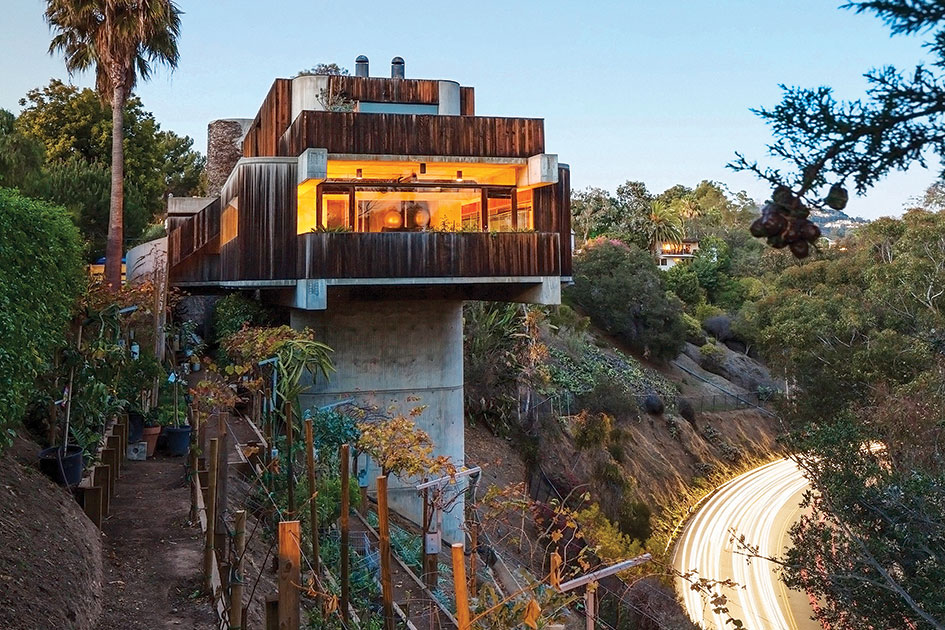Cliff Hanger
Who built that amazing house? A Reedie, of course.
It appears to have been set down on a freeway viaduct by a funnel cloud. Built in the Brutalist style, the house looms 70 feet above Sunset Boulevard, the cynosure of LA cool.
Constructed largely of concrete and wood, it is nonetheless a magnet for architectural junkies and Hollywood tour buses. Everyone from the New York Times to passing motorists wants to know: what’s the story?
Robert Bridges ’74 designed and, with the help of two other guys, spent six years building this house. He poured runnels of concrete, built the furniture, and in 1991 took occupancy with his wife and three sons.
“Brutalism is an unfortunate architectural term,” Robert says. “It has to do with a kind of naked expression of structure. After the two world wars, through modernism there was a desire to remove adornment and express structure. Brutalism was a style along that path.”
The house appears to float on the horizon, but is anchored by 68 driven steel pilings, each 13-inches in diameter. Barring force majeure, it’s not going anywhere.
A Los Angeles native, Robert studied at Columbia University before transferring to Reed. The early ’70s were an exciting time at Reed: Steve Jobs was on campus, classes were small, and the environment was conducive to serious scholarship. Robert enjoyed classes with Prof. T.C. Price Zimmerman [history 1964–77] and Prof. Owen Ulph [history 1944-–79]. He majored in American studies and wrote his thesis on land-use planning with Prof. John Stryker [political science 1972–76]. He also had fun playing handball with Prof. Jerry Rosenblum [art 1970–74], who kindled a latent interest in fine art.
By the time he graduated, however, the devastating effects of the OPEC oil embargo were rippling through the economy.
“It was a very desperate time,” he remembers. “There were no Wall Street jobs, venture capital positions or teaching positions. My job opportunities were doing construction on the Alaska Pipeline or working in the fish hatchery on the Columbia River. It was a very different world. But I survived and am proud of what I’ve accomplished.”
While at Reed, Robert discovered a talent for building and selling homes. A house he purchased, remodeled, and lived in as a student sold for twice what he had paid when he graduated. From then on, he kept a hand in building and real estate.
After obtaining a degree from the Southern California Institute of Architecture, he began designing homes for clients. But he realized that his business required more knowledge of finance, which was a field that interested him. He got a master’s of real estate development from the University of Southern California and now teaches real estate finance in both the graduate and undergraduate programs at USC’s Marshall School of Business. As a consultant, Robert specializes in real estate feasibility studies for large development projects.
“I’ll look at a site and make recommendations about its highest and best use,” he says. “It involves architecture and finance, and is a synthesis of everything I’ve already done.”
As someone who’s journeyed down many paths in higher education, he can argue persuasively for both liberal arts and preprofessional degrees.
“The preprofessional degree doesn’t do a real good job of educating people,” he says, “but we place kids in jobs that sometimes pay in excess of $100,000. We do a really good job of preparing kids to go out and be productive, creating products and services—the material things that society needs.”
On the other hand, there is lasting value to a liberal arts education.
“The humanities allow us to assume our place in the continuum of history and understand the experience of our predecessors in the broadest possible way,” Robert says. “Man has been on earth too long for us to think that we are unique, that others coming before us haven’t had some of the same thoughts, ideas, feelings, and inspirations. We stand on the shoulderes of others rather than reinvent the wheel constantly.”
A perfect world, he says, would enable a student to combine the liberal arts experience with a graduate degree, though it is an elitist model not all can afford.
“It hearkens back to the ancient concept of what a baccalaureate degree is,” Robert explains. “The term bachelor means you’re not wedded to a particular discipline. The master’s degree is where one gains mastery in a particular field, and a doctoral degree means that you administer to the educational needs of your practice.”
One might take issue with Robert’s opinions of preprofessional versus the liberal arts, but as his house is built of concrete, he can safely throw stones.
Tags: Cool Projects, Alumni, Life Beyond Reed
